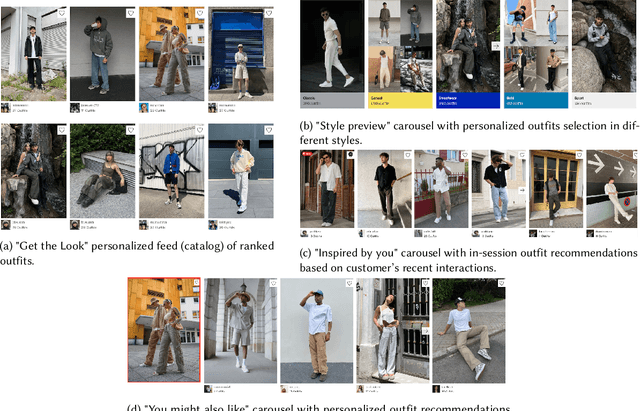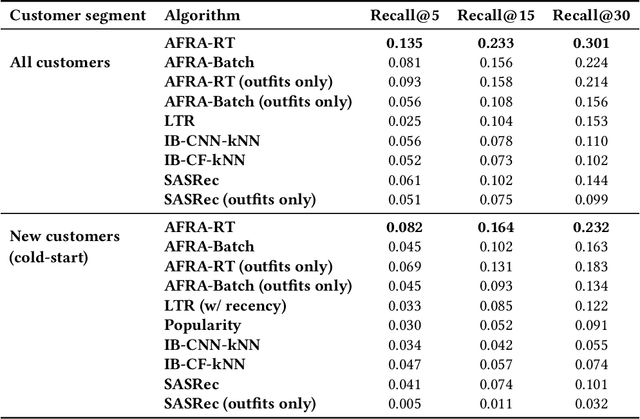Marjan Celikik
Reducing Popularity Influence by Addressing Position Bias
Dec 11, 2024Abstract:Position bias poses a persistent challenge in recommender systems, with much of the existing research focusing on refining ranking relevance and driving user engagement. However, in practical applications, the mitigation of position bias does not always result in detectable short-term improvements in ranking relevance. This paper provides an alternative, practically useful view of what position bias reduction methods can achieve. It demonstrates that position debiasing can spread visibility and interactions more evenly across the assortment, effectively reducing a skew in the popularity of items induced by the position bias through a feedback loop. We offer an explanation of how position bias affects item popularity. This includes an illustrative model of the item popularity histogram and the effect of the position bias on its skewness. Through offline and online experiments on our large-scale e-commerce platform, we show that position debiasing can significantly improve assortment utilization, without any degradation in user engagement or financial metrics. This makes the ranking fairer and helps attract more partners or content providers, benefiting the customers and the business in the long term.
Building a Scalable, Effective, and Steerable Search and Ranking Platform
Sep 04, 2024Abstract:Modern e-commerce platforms offer vast product selections, making it difficult for customers to find items that they like and that are relevant to their current session intent. This is why it is key for e-commerce platforms to have near real-time scalable and adaptable personalized ranking and search systems. While numerous methods exist in the scientific literature for building such systems, many are unsuitable for large-scale industrial use due to complexity and performance limitations. Consequently, industrial ranking systems often resort to computationally efficient yet simplistic retrieval or candidate generation approaches, which overlook near real-time and heterogeneous customer signals, which results in a less personalized and relevant experience. Moreover, related customer experiences are served by completely different systems, which increases complexity, maintenance, and inconsistent experiences. In this paper, we present a personalized, adaptable near real-time ranking platform that is reusable across various use cases, such as browsing and search, and that is able to cater to millions of items and customers under heavy load (thousands of requests per second). We employ transformer-based models through different ranking layers which can learn complex behavior patterns directly from customer action sequences while being able to incorporate temporal (e.g. in-session) and contextual information. We validate our system through a series of comprehensive offline and online real-world experiments at a large online e-commerce platform, and we demonstrate its superiority when compared to existing systems, both in terms of customer experience as well as in net revenue. Finally, we share the lessons learned from building a comprehensive, modern ranking platform for use in a large-scale e-commerce environment.
Reusable Self-Attention Recommender Systems in Fashion Industry Applications
Jan 17, 2023Abstract:A large number of empirical studies on applying self-attention models in the domain of recommender systems are based on offline evaluation and metrics computed on standardized datasets. Moreover, many of them do not consider side information such as item and customer metadata although deep-learning recommenders live up to their full potential only when numerous features of heterogeneous type are included. Also, normally the model is used only for a single use case. Due to these shortcomings, even if relevant, previous works are not always representative of their actual effectiveness in real-world industry applications. In this talk, we contribute to bridging this gap by presenting live experimental results demonstrating improvements in user retention of up to 30\%. Moreover, we share our learnings and challenges from building a re-usable and configurable recommender system for various applications from the fashion industry. In particular, we focus on fashion inspiration use-cases, such as outfit ranking, outfit recommendation and real-time personalized outfit generation.
Outfit Generation and Recommendation -- An Experimental Study
Nov 29, 2022Abstract:Over the past years, fashion-related challenges have gained a lot of attention in the research community. Outfit generation and recommendation, i.e., the composition of a set of items of different types (e.g., tops, bottom, shoes, accessories) that go well together, are among the most challenging ones. That is because items have to be both compatible amongst each other and also personalized to match the taste of the customer. Recently there has been a plethora of work targeted at tackling these problems by adopting various techniques and algorithms from the machine learning literature. However, to date, there is no extensive comparison of the performance of the different algorithms for outfit generation and recommendation. In this paper, we close this gap by providing a broad evaluation and comparison of various algorithms, including both personalized and non-personalized approaches, using online, real-world user data from one of Europe's largest fashion stores. We present the adaptations we made to some of those models to make them suitable for personalized outfit generation. Moreover, we provide insights for models that have not yet been evaluated on this task, specifically, GPT, BERT and Seq-to-Seq LSTM.
* fashionXrecsys '20: Workshop on Recommender Systems in Fashion, 14th ACM Conference on Recommender Systems, September 22--26, 2020, Virtual Event, Brazil
Reusable Self-Attention-based Recommender System for Fashion
Nov 29, 2022



Abstract:A large number of empirical studies on applying self-attention models in the domain of recommender systems are based on offline evaluation and metrics computed on standardized datasets, without insights on how these models perform in real life scenarios. Moreover, many of them do not consider information such as item and customer metadata, although deep-learning recommenders live up to their full potential only when numerous features of heterogeneous types are included. Also, typically recommendation models are designed to serve well only a single use case, which increases modeling complexity and maintenance costs, and may lead to inconsistent customer experience. In this work, we present a reusable Attention-based Fashion Recommendation Algorithm (AFRA), that utilizes various interaction types with different fashion entities such as items (e.g., shirt), outfits and influencers, and their heterogeneous features. Moreover, we leverage temporal and contextual information to address both short and long-term customer preferences. We show its effectiveness on outfit recommendation use cases, in particular: 1) personalized ranked feed; 2) outfit recommendations by style; 3) similar item recommendation and 4) in-session recommendations inspired by most recent customer actions. We present both offline and online experimental results demonstrating substantial improvements in customer retention and engagement.
* FashionXRecSys'22: Workshop on Recommender Systems in Fashion, September 23, 2022, Seattle, WA. Parts published in RecSys 2022 (industry track)
 Add to Chrome
Add to Chrome Add to Firefox
Add to Firefox Add to Edge
Add to Edge